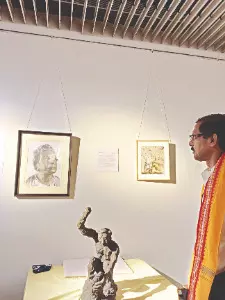Kolkata pays homage to radical vision of Ramkinkar Baij

KOLKATA: On full moon nights, a slightly tipsy Ramkinkar Baij would hum Rabindra Sangeet as his trusted rickshaw puller, Shibu, ferried him from the Kopai River to his home in Bhubandanga, Bolpur. Shibu’s rickshaw was Baij’s preferred mode of travel.
Satya Kinkar Adhikari (48), Baij’s adopted grandson, remembers him as a warm-hearted man who revered Rabindranath Tagore like a god. “In both joy and sorrow, he would break into Rabindra Sangeet. For him, Tagore was everything,” said Satya. He also recalled how Tagore himself would visit Bhubandanga for tree plantations and meet Baij.
A painter himself, Satya creates art using tree roots. He was in Kolkata on Saturday for an exhibition and book launch dedicated to Baij, the trailblazing sculptor and painter who revolutionised Indian art. Held at Nazrul Tirtha, New Town, the event showcased Baij’s original paintings and sculptures, celebrating his bold artistic legacy. Titled ‘Exploring Ideas of Progress’, the exhibition is open to the public until March 31.
Satya’s mother, Aloka, was adopted by Baij when she was a young girl living in Ratan Pally. It was Baij who named Satya. Though he was only three or four when Baij, hailed as the ‘Father of Modern Indian Sculpture’, passed away in 1980, Satya still recalls the artist’s habit of sketching sunflowers and gifting the residents of Santiniketan on special occasions. But his most vivid memories are of Radharani Devi, Baij’s lifelong companion.
“He never married, but he was a family man. Radharani Devi was my grandmother in every sense. She took care of him until his last breath,” reminisced Satya, who now lives with his family in the same Bhubandanga home Baij once resided, now called Kinkar Kuthi. Satya also contributed to ‘The Unseen Life of Ramkinkar Baij’, a book by Chandranath Das and co-authored by Chandrima Das. The book offers a rare glimpse into the life and creative journey of one of India’s most influential modern artists, revealing little-known aspects of his personality and evolution as a sculptor, painter, and graphic artist.
The exhibition at Nazrul Tirtha showcases six works of Baij, including four paintings and two sculptures. A pioneer in modern Indian sculpture and painting, Baij’s fearless creativity continues to inspire new generations. The exhibition also features masterpieces by iconic artists such as MF Husain, Abdur Rahman Chughtai, KG Subramanian, and Tyeb Mehta among others.



